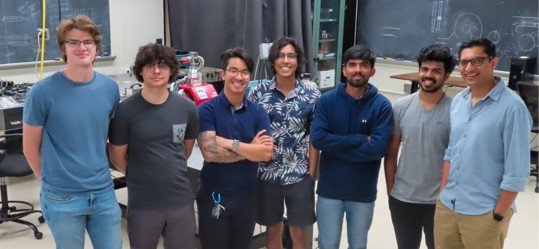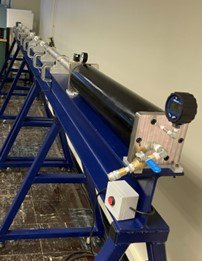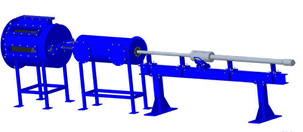Solidly built: Dr. Ravindran's lab now coming together

When Dr. Suraj Ravindran joined AEM as an assistant professor in the Solid Mechanics and Materials group in the fall of 2022, Suraj, as he goes by, had been working to establish a new cutting-edge experimental lab to support his research on understanding material behavior in high/hypervelocity impact applications. He found it was much easier than he initially thought because of the substantial support from the lab facilities already in place within AEM.
Suraj was able to acquire the necessary equipment to support the lab’s overarching objective of facilitating and expediting the development of advanced materials tailored for extreme environments by investigating the intricate mechanisms of deformation and failure at varying length scales from nm to µm and time scales from ns to µs. He has also brought on several students, including Ph.D. candidates Peter Yip and Rushikesh Kabadi, a master's student Mouliswar Ramapuram Ramakumaresan, and six dedicated undergraduates; Bodie Ziertman, Justin Robinson, Pranav Kartha, Vladimir Kornev, Max Welty, and Rick Marcusen to help with both research and set up of the lab.
This experimental facility has several advanced tools and setups to study how materials behave under extreme conditions, like those experienced in space, war fields, or during hypersonic flights. The team is building a single-stage gun that can shoot relatively large projectiles up to 2.5 km/s, allowing us to understand how these advanced materials in aerospace applications hold up under pressures greater than 0.5 million atm and ultra-fast deformations.

“We are developing a two-stage gun that can accelerate projectiles up to 7.0 km/s to obtain meteoroid-like speeds in laboratory settings. This experimental facility can simulate debris impact on satellites, help study crater formation on planets due to high-speed impacts, and study many physical phenomena observed in extreme conditions,” said Suraj. He and his team are also collaborating with the Advanced Photon Source (APS) research group within the Argonne National Laboratory based in Chicago, which will help to further develop an understanding of atomic scale mechanisms in materials.
Currently, the lab remains under construction, with Suraj’s student team members taking the lead on coordinating and installing various equipment pieces. Bodie and Justin built a split Hopkinson bar setup with dynamic fracture capability, as Bodie studies the dynamic fracture toughness of ballistic materials. Moulishwar developed a high-speed Photonic Doppler velocimeter and a microscale split Hopkinson bar to study the extreme strain rate behavior of materials. Peter is working on developing the laser shock facility and simulating the particle impact effects on Hypersonic vehicles. Pranav, Vladimir, and Moulishwar are automating high-rate experiments, which will be ready before the end of summer. Finally, to prepare for the plate impact facility which is set to arrive in the last week of September, Rushikesh, Moulishwar, and Bodie traveled to Caltech over the summer to train and learn about plate impact experiments and the intricacies involved in these unique experiments.
When completed, the lab will encompass a world-leading facility for studying material behavior under extreme conditions. Suraj stated, “We are excited that our experimental facility is coming quite fast, which will help solve outstanding problems in the mechanics of materials under extreme conditions.”
